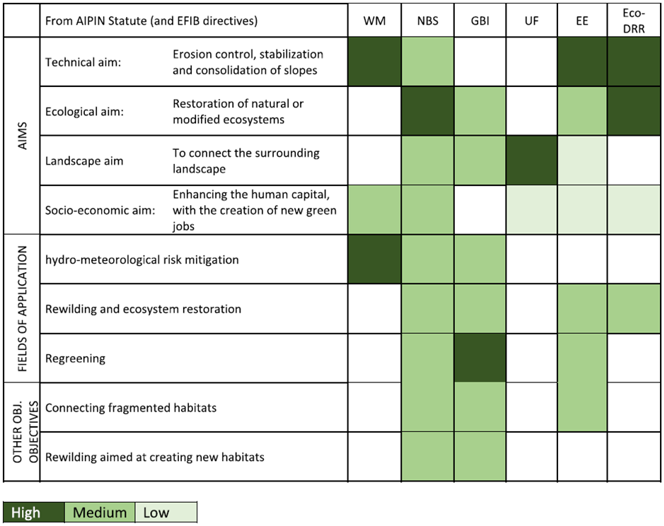Is Soil and Water Bioengineering an NBS?

The review paper that explores similarities and differences on Soil and Water Bioengineering (SWB) and Nature-based Solutions (NBS) has been published in the journal “Ecological Engineering”.
The work was started from the need to have a structured comparison of SWB and NBS, much needed to highlight that SWB are amenable to the concept of NBS in the context of climate change adaptation and disaster risk reduction (DRR). This is not only important to understand overlaps, but also when definitions are linked to legislations and funding mechanisms.
Materials and methods
A matrix was created to compare NBS and NBS-related terminologies with the three main aspects of the SWB practice: “main aims”, “fields of application” and “other objectives”.
In addition to NBS, terminologies that are analysed include: Watershed Management or hydraulic-forestry arrangements (WM), NBS, Green/blue Infrastructure (GI), Urban Forestry (UF), Ecological Engineering (EE), as well as Ecosystem-based Disaster Risk Reduction (Eco-DRR).
The three main aspects of SWB practice were taken from the statute of the AIPIN – Italian Association of Soil and Water Bioengineering (http://www.aipin.it/), which is among the first established statues of SWB in Europe, following the Verein für Ingenieurbiologie. The aspects considered in the comparison matrix cover the following:
– main aims: the four main objectives of SWB; namely: technical, ecological, landscape and socio-economic objectives;
– fields of application: main domains of applications and fields of interventions, such as; i) slope stabilization, wetland restoration and streambank protection, coastal defence; ii) rewilding and contribution to ecological restoration of degraded areas; iii) environmental requalification;
– other objectives: the multi-purpose functions exerted by SWB.
Excerpts from relevant peer-review and grey literature as well as EU reports about NBS and related terms were included in the matrix to cross-check the 3 main aspects of the SWB practice. More emphasis was given to EU reports, which define what is and what is not an NBS, setting up the course for future legislations.
Table 2 shows the comparison
Discussion
The main findings from this comparison are: (1) SWB approaches have at least 2 “aims” in common with all the terms; (2) all 3 main aspects are covered by the NBS definitions (Table 3). In terms of “fields of application”, the highest number of similarities are found between SWB and EE, and, to a smaller extent, WM, GBI and Eco-DRR. Ecological engineering (EE) is indeed often considered a practice equivalent to SWB, using an ecosystem-based approach to manage hazards.
The category “other objectives” includes secondary scopes of SWB applications, such as rewilding, ecosystem restoration of fragmented habitats, and biodiversity protection. All of these represent important aspect of NBS practice and also pertain to the concepts of GBI (i.e., the use of green corridors) and EE. This confirms that SWB can be an effective tool for environmental improvement and recovery of biodiversity in degraded ecosystems.

Summary of the comparison matrix where the green coloured cells represent matches of NBS-related definitions with SWB definitions. The three different intensities of the colour indicate the level of importance for each NBS-related term in the authors’ subjective assessment, from the darker (high importance) to the lighter (low importance). The NBS-related terms used in the table are: Watershed Management (WM), Nature-based solutions (NBS), Green-blue Infrastructure (GBI), Urban Forestry (UB), Ecological Engineering (EE); Ecosystem-based Disaster Risk Reduction (Eco-DRR).
This work was carried out to illustrate and document that SWB discipline can be recognized as a concept falling under the NBS umbrella concept. It overlaps and, in some cases, compliments many NBS-related terminologies. These concepts strive to complement one another and are not conflicting, but rather supporting.
Source: Preti F., Capobianco V., Sangalli P. 2022. Soil and Water Bioengineering (SWB) is and has always been a nature-based solution (NBS): a reasoned comparison of terms and definitions. Ecological Engineering. https://doi.org/10.1016/j.ecoleng.2022.106687
Contact person from PlaNet: Vittoria Capobianco (NGI); vittoria.capobianco@ngi.no